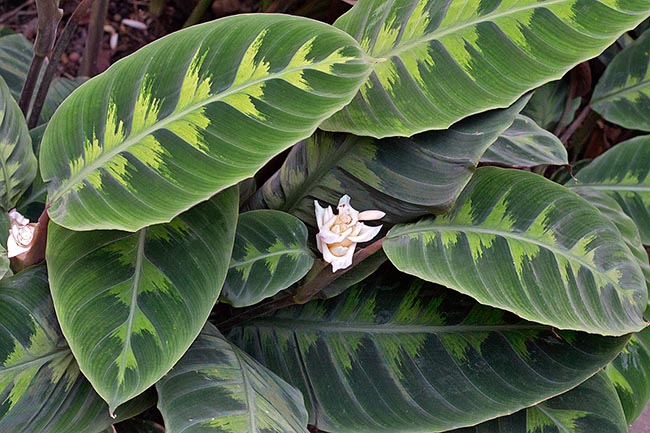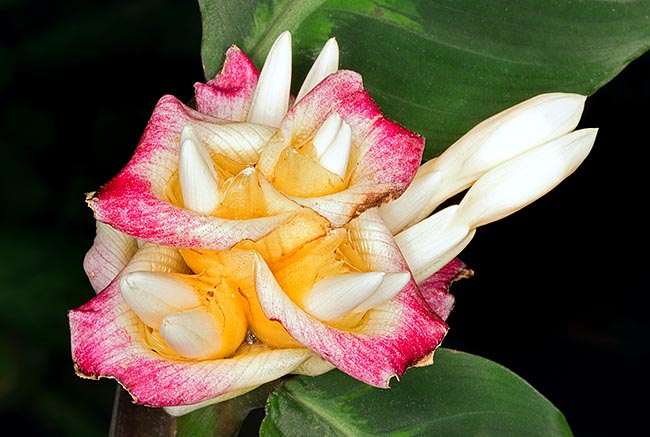Family : Marantaceae

Text © Pietro Puccio

English translation by Mario Beltramini

Native to Central America, Goeppertia warszewiczii makes elegant edges in the tropical gardens © Giuseppe Mazza
The genus is honoured to the German botanist and paleontologist Johann Heinrich Robert Goeppert (1800-1884); the species is honoured to the Polish gardener and collector of plants and animals Józef Warszewicz Ritter von Rawicz (1812-1866) who introduced it in cultivation in Berlin.
Common names: Warscewicz’s Calathea (English); planta zebra (Spanish).
The Goeppertia warszewiczii (Lem.) Borchs. & S.Suárez (2012) is an evergreen, perennial, rhizomatous herbaceous species, forming 0,5-1,2 m tall tufts with 3-7 leaves merged in a basal rosette, on a 1-30 cm long tomentose, dark purple petiole and usually 2, rarely 1-3, almost sessile leaves at the apex of a 0,5-1 m long stem ending with the inflorescence.
The leaves are ovate to oblong-lanceolate with pointed apex, the basal ones are 18-45 cm long and 10-20 cm broad and the cauline ones are 8-35 cm long and 5-15 cm broad, dark green on the upper page with velvety reflections with at the centre irregular fishtail shaped yellowish green spots, tomentose below and of dark purple colour. The inflorescence is terminal, 4-7 cm long and 3-5 cm of diameter, on 5-10 cm long green pubescent peduncle, formed by 4-16 imbricate ovate bracts spirally arranged, coriaceous, with usually curved edge, about 3 cm long and 3-5 cm broad, of white colour tending, with the time, to purple red; the bracts contain up to 8 pairs of tubular flowers with white or cream white corolla, about 3 cm long, opening in succession.

The even 5 cm broad and 7 tall candid inflorescences, ageing become purple red © Giuseppe Mazza
It requires protection from the wind, high humidity, 70-80%, and constant temperatures, ideal 20-26 °C. Where the climate does not allow the permanent cultivation in open air, it can be cultivated in pot in order to be sheltered during the coldest months in luminous location and far from air currents with temperatures not less than 16 °C, regular watering, but without stagnations which may cause fatal rottenness, preferably using rain water, from reverse osmosis of demineralised, and high ambient humidity, for this are useful nebulisations with non calcareous water for avoiding antiaesthetic spots on the leaves. The fertilizations, duly distributed and alternated, in way to avoid salts accumulations on the roots, are to be done during the vegetative period with balanced hydro-soluble products, with microelements, at ¼ the dosage suggested on the package.
Synonyms: Maranta warszewiczii L. Mathieu (1853); Calathea warszewiczii (L. Mathieu ex Planch.) Planch. & Linden (1855); Phyllodes warszewiczii (Lem) Kuntze (1891).
